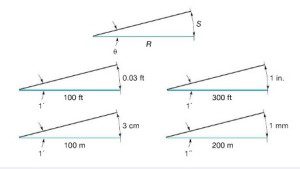Answer
Definition
A minute of arc, arcminute, or minute arc (MOA), is a unit of angular measurement equal to one sixtieth (1/60) of one degree. In turn, a second of arc or arcsecond is one sixtieth (1/60) of one arcminute. Because one degree is defined as one three hundred and sixtieth (1/360) of a rotation, one minute of arc is (1/21,600) of a rotation, which also equals (PI/10,800) radians. It is used in those fields that require a unit for the expression of small angles, such as astronomy, optometry, ophthalmology, optics, navigation and marksmanship. The arcsecond is (1/3,600) of a degree, or (1/1,296,000) of a circle, or (PI/648,000) radians (which is approximately (1/206,265) radians).
Relationship of Angles and Distance
Determining the relative positions of point often involves observing of both angles and distances. The best quality surveys result when there is computability between the accuracies of these two different kinds of measurements. The formula for relating distances to angles is given by the geometric relationship
S=R * Angle
In the equation above, is the arc length substended at a distance by an arc of in radians. To select instruments and survey procedures necessary for achieving consistency, and to evaluate the effects of errors due to various sources, it is helpful to consider the relationships between angles and distances given here and illustrated in the figure below.
1’ of arc = 0.03 ft at 100 ft, or 3 cm at 100 m (approx..)
1’ of arc = 1 in. at 300 ft (approx.; actually 340 ft)
1” of arc = 1 ft at 40 mi, or 0.5 m at 100 km, or 1 mm at 200 m (approx.)
1” of arc = 0.000004848 radians (approx.)
1 radian = 206,264.8” of arc (approx.)
In accordance with the relationships listed an error of approximately 1 min results in an observed angle if the line of sight is misdirected by 1 in. over a distance of 300 ft. This illustrates the importance of setting the instrument and targets over their respective points precisely, especially where short sights are involved. If an angle is expected to be accurate to within +-5″ for sights of 500 ft, then the distance must be correct to within 500(5”)0.000004848 = +-0.01 ft for compatibility.
To appreciate the precision capabilities of a high-quality total station, an instrument reading to the nearest 0.5” is capable of measuring the angle between two points approximately 1 cm apart and 4 km away theoretically! However, errors from centering the instruments, sightings the point, reading the circle, and other sources, make it difficult, if not impossible, to actually accomplish this accuracy.
Example
If you are deciding between getting two instruments and your survey angles expected to be within +-3″ of arc versus +-5″ of arc for sights of 1500 ft the example below will give you a good idea of what level of accuracy will you achieve with different instruments:
If an angle is expected to be accurate to within +-3″ for sights of 1500 ft, then the distance must be correct to within 1500(3”)0.000004848 = +-0.02 ft for compatibility.
If an angle is expected to be accurate to within +-5″ for sights of 1500 ft, then the distance must be correct to within 1500(5”)0.000004848 =+-0.04 ft for compatibility.
So if you are looking to get more precise and accurate reading you should go with the 3” of arc, but if you can tolerate the difference between 5”and 3” of arc of (+-0.04) – (+-0.02)= +-0.02 ft you should be better of getting the 5” of arc.
Resource:
- Ghilani, Charles & Wolf, Paul. Elementary of Surveying (an introduction to Geomatics) thirteenth edition
- Wikipedia



